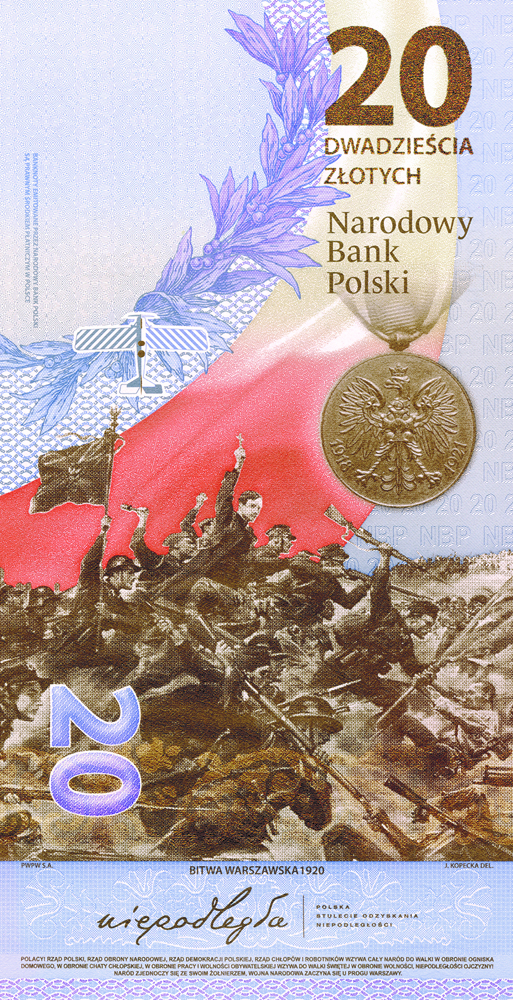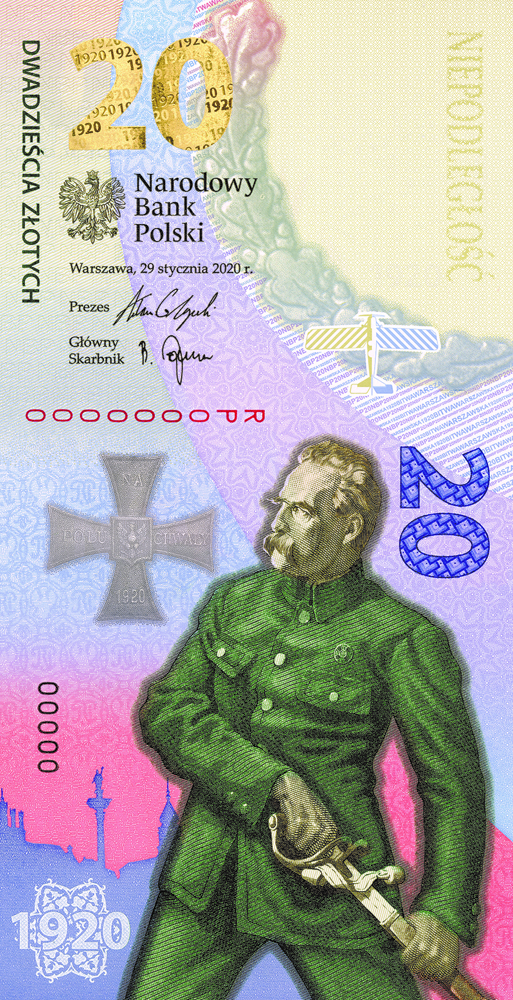The National Bank of Poland commemorates the 100th anniversary of the Battle of Warsaw in 1920 with a collector’s banknote in a 20 PLN denomination. The bill is of particular interest to collectors due to the vertical orientation of graphic elements.

Collector’s banknote: ”Battle of Warsaw 1920”
Face value: 20 PLN,
Size: 77mm x 150mm,
No. of impressions: up to 60 000 copies,
Designer: Justyna Kopecka,
Date of issue: 11th September 2020,
Issuer: NBP,
Producer: Polish Security Printing Works
commissioned by NBP
The total war between the partitioning states, which Adam Mickiewicz prayed for, gave the Poles a chance to regain their independence. The road to freedom, however, was nowhere near the end. The Poles, as subjects of enemy powers, were forced to fight for others’ causes in the partitioning states’ armies and paid the price in blood. Some of them, however, wore national uniforms. Riflemen donned a simple grey outfit when, in August 1914, under Józef Piłsudski, they entered the borders of the Kingdom of Poland to fight against Russia. They were convinced that only an armed rebellion would bring back their desired independence, which generations fought for to no avail.
Following in the tracks of the First Cadre Company, more units were created, out of which three brigades were formed. Their wartime saga, fierce and bloody fighting on the banks of the Nida river, in the Carpathians, Mazovia, around Lublin and Wołyń were of great importance to the national issue of independence. The actions of the legionaries also drew in attention from far and wide. Some of them were detained, because they refused to swear allegiance to the central powers. Others broke through the front lines and fought against the Germans. These events had an undeniable influence on the creation of the myth about the Legions and Józef Piłsudski.

The imprisonment of the future Head of State by the Germans strengthened his legendary status of an unbreakable fighter for Poland. It should not come as a surprise that when he returned from captivity in Magdeburg, the very next day – on the 11th of November 1918, he was given power over the state and command of the armed forces by the Regency Council. This date, over the course of time, was symbolically hailed as the day Poland regained its independence.
Józef Piłsudski vigorously started to organise the government and the army. As the Commander in Chief of the Polish Army, on the 16th of November, he notified the powers of the rebirth of an independent, sovereign and democratic state of Poland. The fragments of this notification are visible on the front side of the banknote, beside the portrait of Józef Piłsudski in his legionary uniform.
Another reference to the subject of the Legions is the commemorative badge of the 1st Brigade of Polish Legions and the badge of the Polish Military Organisation, which had a large role in taking power in the country and strengthening its borders. On both the badges, apart from the abbreviations of the organisations’ names, the initials JP – Józef Piłsudski – are visible. The front page is completed by a schematic display of the Order of Polonia Restituta with the date 1918 engraved in it, as well as the word ”niepodległa” (independent) – based on Józef Piłsudski’s handwriting. The word is also the logotype in the programme for the celebrations of the 100th anniversary of Poland’s independence.
Source: NBP
The Battle of Warsaw, also called “the Miracle on the Vistula”, was the decisive battle which took place from the 13th to the 25th of September 1920, between the units of the Soviet Red Army and the units of the Polish Army grouped around the Vistula river.
On the verge of defeat, the Polish Army’s units managed to push back and defeat the oncoming Western Front Soviet army led by Michail Tukhachevsky. The Polish victory in the battle drastically changed the war’s direction, let the reviving Poland keep its independence, and scrapped the Soviets’ plans to attack Western Europe as well as their plan to stage an international revolution.
The battle started on the 13th of September 1920, when the Red Army, commanded by Michail Tukhachevsky, approached Warsaw. It took place in an area stretching from the south-eastern town of Włodawa on the Bug river, to the north-western village of Działdowo. The defensive phase of the fighting concentrated on the Northern Front under General Józef Haller’s command. The 1st Army under General Franciszek Latinik was initially forced to pull back in the Radzymin area towards the 2nd line of defence between Nieporęt and Rembertów. It did, however, halt the Soviet advance on the Warsaw bridgehead. On the 14th of September, the Polish 5th Army under General Władysław Sikorski took up offensive action around the river Wkra.
The decisive blow to the Soviet armies was delivered by the strike force under Commander in Chief Józef Piłsudski. He conducted a counterattack, heading from the Wieprz river, breaking through the front at Kock and Cyców, finally arriving behind the lines of the Soviet armies attacking Warsaw. The Polish Army’s actions led to a disorganised retreat of the Red Army to the east. The Soviets suffered enormous casualties. From that moment forward, the Polish Army remained on the offensive for the following weeks.
According to Edgar D’Abernon, a British politician and diplomat, the Battle of Warsaw was one of the eighteen groundbreaking battles in the world’s history.
Source: Wikipedia.org


